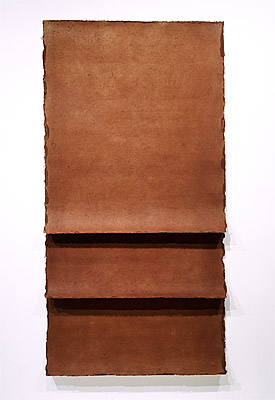Michelle
STUART
United States of America
1938
Breezy Point, New York
1976
earth, rag paper, muslin
signed and dated verso largest sheet u.l., pencil, "Michelle Stuart / 1976"
overall
311.3 (h)
x 158.5 (w)
cm
Purchased 1978
National Gallery of Australia, Canberra
NGA 1978.384
The visual delicacy and apparent fragility of Michelle Stuart’s Breezy Point, New York evokes concerns for the environment. In the 1970s Stuart established herself as one of the foremost American artists concerned with the landscape. She has traced her interest in ‘mapping’ the landscape to childhood experiences accompanying her father, an engineer and avid traveller, on field trips through southern California, and to her employment as a topographical draughtsperson and cartographer following her initial art school training. By the early 1970s Stuart was producing large graphite drawings on paper, ‘rubbings’ over rough surfaces of rock, sand, or metal, the resulting leaden look reminiscent of the mineral origins of graphite.[1]
In a natural progression, from 1973 Stuart began to work directly with earth and rocks as the materials for mark-making. Working both outdoors and in her studio, she used large rocks as pestles to reduce others to powders—effectively dry earth pigments—while at the same time embossing the surface of the paper in a manually repetitive, ritualistic process. She then removed any loose material, polishing the work to a sheen with her palms. The resulting roughly edged sheets, or more aptly ‘scrolls’, are pinned to the wall, often singly, sometimes as a series of ‘panels’, or in overlapping layers as in Breezy Point, New York.
The title identifies the location—the exposed Breezy Point Park across the bay from metropolitan Brooklyn—where the topsoil layer that provided the raw materials for the work was extracted; the deep rich reddish-brown colour is specific to the soils and rock types at this site.[2] Stuart’s work is an immediate and personal record of the current environment, of human presence and interaction, a preoccupation with the cultural significance of the landscape. The earth surface of Breezy Point, New Yorkis gloriously tactile and seems to ‘breathe’ light, a manifestation of the ‘sublime’ in the union of nature and art.[3]
Adapted from an unpublished manuscript by Steven Tonkin 2003[4]
then Assistant Curator, Research
National Gallery of Australia, Canberra
[1] Lawrence Alloway, ‘Michelle Stuart’, in Michelle Stuart, Fine Arts Center Gallery, State University of New York at Oneonta, 1975, p 2
[2] As Michael Wardell observed, Stuart’s ‘finished form is not a realistic representation of the landscape, nor is it an exact geological sample of the earth’s surface. It is rather a metaphorical recreation of the processes of natural weathering and erosion.’ Michael Wardell, ‘Michelle Stuart’ in Landscape–Art: two way reaction, Australian National Gallery, Canberra, 1980, p 18
[3] Although usually linked to Land and Environmental Art, Stuart’s work also has visual affinities to Colour Field painting, especially Mark Rothko’s
[4] ‘Michelle Stuart: Breezy Point, New York’, in ‘American painting and sculpture in the National Gallery of Australia’, 2004, unpublished ms

